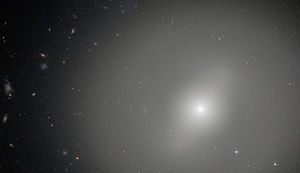- NGC 1533
-
NGC 1533 
Observation data (J2000 epoch) Constellation Dorado Right ascension 04h 09m 51.8s[1] Declination -56° 07′ 06″[1] Redshift 790 ± 5 km/s[1] Distance 62 ± 4 Mly (19.0 ± 1.1 Mpc)[2][a] Type (L)SB(rs)00[1] Apparent dimensions (V) 2′.8 × 2′.3[1] Apparent magnitude (V) 11.7[1] Other designations PGC 14582[1] See also: Galaxy, List of galaxies NGC 1533 is a barred lenticular galaxy with faint spiral structure in the constellation Dorado and the seventh brightest member of the Dorado Group and 1°[3] off the group's center.[2] It is surrounded by a vast arc or ring of H I which is connected to IC 2038 and IC 2039.[2] The ring orbits around 32 kpc from the center.[3][b] It is typical of lenticular galaxies in that star formation is weak in NGC 1533.[2] Using both the surface brightness fluctuation (SBF) and globular cluster luminosity function (GCLF) methods, its distance was estimated in 2007 to be 19.4 ± 1.1 Mpc and 18.6 ± 2.0 Mpc respectively.[2] Averaging these together gives a distance of around 19 million parsecs or 62 million light-years from earth.[a] In 1970, a supernova was detected in NGC 1533.[4]
NGC 1533 was discovered by John Herschel on December 5, 1834.
Notes
References
- ^ a b c d e f g "NASA/IPAC Extragalactic Database". Results for NGC 1533. http://nedwww.ipac.caltech.edu/. Retrieved 2008-06-26.
- ^ a b c d e DeGraaff, Regina Barber; Blakeslee, John P.; Meurer, Gerhardt R.; Putman, Mary E. (December 2007). "A Galaxy in Transition: Structure, Globular Clusters, and Distance of the Star-Forming S0 Galaxy NGC 1533 in Dorado". The Astrophysical Journal 671 (2): 1624–1639. Bibcode 2007ApJ...671.1624D. doi:10.1086/523640. http://www.iop.org/EJ/article/0004-637X/671/2/1624/72739.html.
- ^ a b c Ryan-Weber, Emma; Webster, Rachel; Bekki, Kenji (April 2003). Jessica L. Rosenberg and Mary E. Putman. ed. Galactic Recycling: The HI Ring Around NGC 1533. 281. Dordrecht: Kluwer Academic Publishers. 223. ISBN 1-4020-1289-6. http://adsabs.harvard.edu/abs/2003ASSL..281..223R
- ^ Evans, R. (1970). "Supernova in NGC 1533.". IAU Circ. 2279 (2279): 1. Bibcode 1970IAUC.2279....1E.
External links
- NGC 1533 on WikiSky: DSS2, SDSS, GALEX, IRAS, Hydrogen α, X-Ray, Astrophoto, Sky Map, Articles and images
- Sky View image of NGC 1533
Coordinates:
 04h 09m 51.8s, −56° 07′ 06″Categories:
04h 09m 51.8s, −56° 07′ 06″Categories:- Barred lenticular galaxies
- Dorado constellation
- Dorado Group
- Ring galaxies
- NGC objects
- PGC objects
Wikimedia Foundation. 2010.
